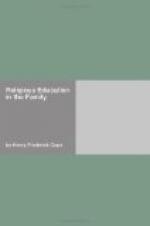2. What are your difficulties in story-telling to children?
3. Is the habit
of reading books passing among children? If so,
what are the reasons?
4. What responsibility
has the public library toward the child’s
selection of books?
toward promoting book reading?
5. How many families co-operate with the library?
6. How might the church co-operate?
7. Does the reading
of newspapers by children affect their general
habits of reading?
In what ways?
8. What personal
difference is there, if any, between the effect of
a borrowed book and
of one the child owns?
FOOTNOTES:
[17] Laura E. Cragin, Kindergarten Bible Stories. Fifty-six of the Old Testament stories. There is also a companion volume of New Testament stories.
James Baldwin, Old Stories of the East. Fresh and interesting versions of the familiar Old Testament stories.
Kate Douglas Wiggin, The Story Hour. Good stories and a suggestive introduction on story-telling.
Half a Hundred Stories for the Little People, by various authors.
[18] A List of Good Stories to Tell to Children under Twelve Years of Age, Carnegie Library of Pittsburgh, $0.05. There are references to books in which the stories may be found, including 25 Bible stories, 16 fables, 14 myths, 14 Christmas stories, 7 Thanksgiving stories, etc.
[19] Such as O’Shea, Old World Wonder Stories; George Hodges, The Garden of Eden; Cragin, Old Testament Stories; Mary Stewart, Tell Me a True Story.
[20] The H.W. Wilson Co., White Plains, New York, publishes a list of Children’s Books for Sunday-School Libraries.
CHAPTER XI
THE USE OF THE BIBLE IN THE HOME
If we keep clearly in mind the aim of religious education in the family as that of the development of the lives of religious persons, the place and value of the Bible will be evident. It will be used as a means of developing and directing lives. This will be quite different from a perfunctory use because our fathers used it or a use under the compulsion of the fear lest some strange evil should befall us, some visitation of an offended deity.
Sec. 1. THE CHILD’S NEED
Children need the Bible as a part of their social heritage. Just as they get a larger life, inspired and stimulated by the realization of their connection with the past of their family and their country, so the Bible brings them into connection with the religious history of the race. General history brings heroic forefathers into the stream of consciousness; we feel the push of their lives. So the Bible reveals the stream farther back and makes us part of the process of life in unity with great characters and great movements.




